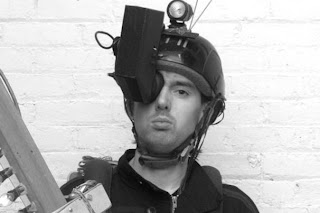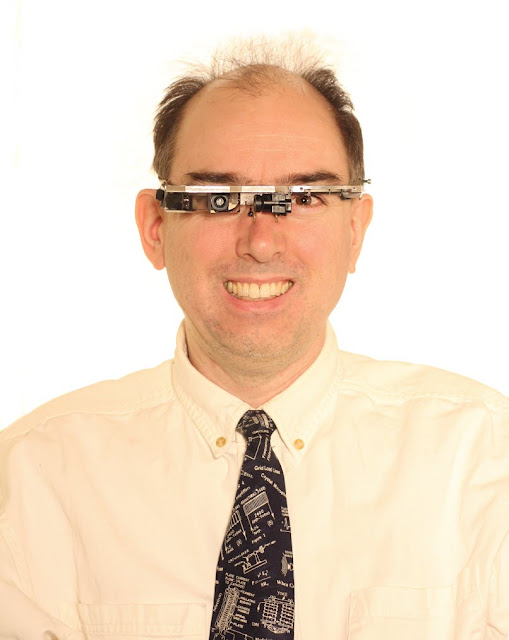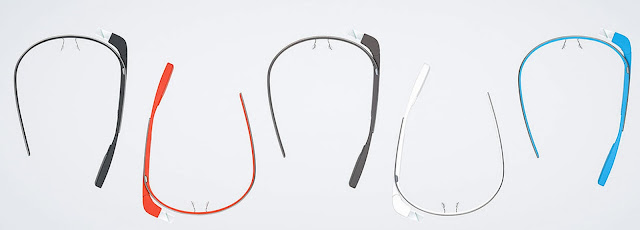On Twitter, the #IfIHadGlass hashtag is going strong with about a tweet every two seconds. If you don’t know about it, it is the hashtag used to inform Google about your desire to get your hands on Google Glass, wearable computing solution from Google. In this article, let’s take a deep look at Google Glass and know how the experience will be. To start with, here, take a look at some of the tweets…
Tweets about "#ifihadglass"
It all started with an abacus ring pioneered by the Chinese Quing dynasty in the 1600’s.
In the 80’s and 90’s we got to see quite a number of wearable innovations. A few of them are here.
In the early 80’s, Dr. Steve Mann, one of the pioneers of wearable computing, invented this largely unappealing apparatus. Rig could be worn, but as you can imagine it is quite easy to go around without it. But again, it was in the 80’s. In the 90’s Steve Mann came up with other inventions, which were a bit better to look at. One of them is the EyeTap shown here.
Here is another invention called Zypad that wraps around your wrist like a watch, a big, big watch!
In 2010, a company called Brother released another invention, quite similar to Google Glass called AiRScouter. Here it is:
Besides these, you are probably quite familiar with the likes of Nike+ FuelBand and Jawbone Up (which I think looks a lot cooler).
If you need to know more of the history of wearables, you can visit Interaction Design Foundation’s wearable computing page.
The latest addition to the wearable computing world is Google’s own product, Glass. If you have never heard about some of those devices mentioned in the history section above (save for the FuelBand and Up), then you are probably wondering why these devices are so rare! They are rare and more or less unpopular. Although some of these wearable inventions can be quite easy to handle, they have never become popular enough.
Google on the other hand is expecting to get people interested in Glass.
Google Glass first made its appearance back in April 2012, when Sergey Brin, the co-founder of Google and chief of Google X (where Glass and other major innovative, secret Google projects are developed), displayed it. On , Sergey was spotted in New York subway train wearing his invention. The guy who spotted him blogged about it (it does rhyme with 'bragged about it' doesn't it?).
Glass is Google’s own augmented reality wearable computing invention that will go on sales by the end of the year (as per latest expectations) or in two. However, if you are a US citizen, you may be able to get your hands on one test device if you fulfill a few Google requirements. That is where we come across the above-mentioned hashtag, #IfIHadGlass and about 1500 dollars.
‘OK Glass’ is a command that you will use quite often if you own one. It starts the computer’s natural language voice recognition system, deeply integrated to Google search. The voice recognition is exactly like how you use it on Android devices. Just add ‘ok glass’ in front.
For instance, in order to take a picture, you say ‘OK glass, take a picture’; to record a video, you say ‘OK Glass, record a video’. Pretty simple indeed!
In effect, Google Glass is just another way technology is shaping our lives. Or trying to shape!
Google Glass project runs Android (we don’t know which version) and does everything with the tight integration to Google. There is no way to input data to the system other than using voice. Also, the capabilities are limited to a few. It doesn’t have as much capability and usability as a smartphone.
We don’t know the details of the features yet, but we expect to know about them soon.
Google Glass sports a lens-less eye-mounted frame that has a tiny display attached with a camera.
In the design front, Google Glass looks pretty awesome with lenses, rather than without them. You could look geeky wearing it, or if you can pull it off, you could look like the main character of a Sci-Fi film.
The product is light and flexible, and yet it is sturdy. The basic Glass without any lenses looks awkward a bit (I mean, why would you wear a pair of eyeglasses without glasses?) It also has quite a number of color choices, just like Google's logo, offices, storage facilities, etc.
There have been quite a bit of talk about how good and chic it is to wear Google Glass. There is already a very fine line between stylish wearables and ridiculous ones. Apple’s soon expected iWatch also is getting mixed response among people. It is definitely not so stylish to wear a wrist-bound computer like the Zypad we saw earlier. There is a huge population that disapproves of wearable technology due to the fact that it could look awkward in public. However, the perception could change if the technology becomes popular.
As far as Google Glass is concerned, I believe it cuts right in the middle ground between what is cool and what is lame. It has the potential to go both ways. When Sergey was wearing it in train, it looked pretty good. When an average Joe wears it in public where no one else does, it could look awkward. But among the pictures we were able to find, the Glass looks pretty stylish on most faces.
Along with this image, where Google Glass is doctored on the faces of the duke and duchess of Cambridge, Prince William and Kate Middleton, we got to see a number of other spoof images (those of Barack Obama, Justin Bieber, Lady Gaga, etc.) of Google Glass. The general idea here is that Glass can look beautiful on your face.
Last year, Steve Mann, the man behind augmented reality wearables was attacked in a McDonald’s in Paris, while wearing his own invention, the EyeTap (see the above picture with Steve Mann wearing EyeTap). He was assaulted by people purporting to be McDonald’s own employees. The story also mentions a lady who was attacked by the same outfit for photographing their menu.
Whether people find it weird or funny to have an eye-mounted computer is yet unknown. However, anything could be stylish if it becomes popular.
We will have to wait and see how Google Glass performs in the market.
We will see quite a number of Glass wearers in a few days. Google will provide Glass to a number of people who apply to become “Glass Explorers”. We have been seeing celebrities taking interest in this test by Google. Here is a tweet by Neil Patrick Harris:
Google Glass is going strong with over 100,000 searches in the United States about it.
Here, take a quiz:
Other than the fact that it is a strong wearable product, I don’t understand the hefty price tag of 1500 dollars. It is more than a few full-fledged laptops and all of the high-end smartphones and tablets. However, this is the Explorer edition shipping right now for the winners of the application process in Google.
Google itself has given us assurance that the actual price of the device should be much lower than that.
Google Glass is definitely an innovative product from the search giant. We are still worried about the future of the device. As we mentioned, it has the potential to be both the next big thing and the laughable tech! With Google’s backing, it has all the potential to succeed. There is also big competition to Google Glass, and one of them is under development in Cupertino itself. Apple has a patent for a head-mounted display computer as well, dated July 2012.
[Update: ]
Google did announce yesterday that the results of the Glass program #ifihadglass are in. That post was made in the Google plus page of the project. Soon enough, we will also know the winners of the project. All of the winners are expected to be individuals.
[Update: ]
Here are a few of the first videos shot with Google Glass. From the people passionate about it, and subsequently got it to test.
[Image courtesy: Interaction-design]
Tweets about "#ifihadglass"
A Brief History of Wearables
It all started with an abacus ring pioneered by the Chinese Quing dynasty in the 1600’s.
In the 80’s and 90’s we got to see quite a number of wearable innovations. A few of them are here.
In the early 80’s, Dr. Steve Mann, one of the pioneers of wearable computing, invented this largely unappealing apparatus. Rig could be worn, but as you can imagine it is quite easy to go around without it. But again, it was in the 80’s. In the 90’s Steve Mann came up with other inventions, which were a bit better to look at. One of them is the EyeTap shown here.
Here is another invention called Zypad that wraps around your wrist like a watch, a big, big watch!
In 2010, a company called Brother released another invention, quite similar to Google Glass called AiRScouter. Here it is:
Besides these, you are probably quite familiar with the likes of Nike+ FuelBand and Jawbone Up (which I think looks a lot cooler).
If you need to know more of the history of wearables, you can visit Interaction Design Foundation’s wearable computing page.
Google Glass
The latest addition to the wearable computing world is Google’s own product, Glass. If you have never heard about some of those devices mentioned in the history section above (save for the FuelBand and Up), then you are probably wondering why these devices are so rare! They are rare and more or less unpopular. Although some of these wearable inventions can be quite easy to handle, they have never become popular enough.
Google on the other hand is expecting to get people interested in Glass.
Google Glass first made its appearance back in April 2012, when Sergey Brin, the co-founder of Google and chief of Google X (where Glass and other major innovative, secret Google projects are developed), displayed it. On , Sergey was spotted in New York subway train wearing his invention. The guy who spotted him blogged about it (it does rhyme with 'bragged about it' doesn't it?).
Glass is Google’s own augmented reality wearable computing invention that will go on sales by the end of the year (as per latest expectations) or in two. However, if you are a US citizen, you may be able to get your hands on one test device if you fulfill a few Google requirements. That is where we come across the above-mentioned hashtag, #IfIHadGlass and about 1500 dollars.
What It Does?
‘OK Glass’ is a command that you will use quite often if you own one. It starts the computer’s natural language voice recognition system, deeply integrated to Google search. The voice recognition is exactly like how you use it on Android devices. Just add ‘ok glass’ in front.
For instance, in order to take a picture, you say ‘OK glass, take a picture’; to record a video, you say ‘OK Glass, record a video’. Pretty simple indeed!
In effect, Google Glass is just another way technology is shaping our lives. Or trying to shape!
Google Glass project runs Android (we don’t know which version) and does everything with the tight integration to Google. There is no way to input data to the system other than using voice. Also, the capabilities are limited to a few. It doesn’t have as much capability and usability as a smartphone.
We don’t know the details of the features yet, but we expect to know about them soon.
Google Glass sports a lens-less eye-mounted frame that has a tiny display attached with a camera.
In the design front, Google Glass looks pretty awesome with lenses, rather than without them. You could look geeky wearing it, or if you can pull it off, you could look like the main character of a Sci-Fi film.
The product is light and flexible, and yet it is sturdy. The basic Glass without any lenses looks awkward a bit (I mean, why would you wear a pair of eyeglasses without glasses?) It also has quite a number of color choices, just like Google's logo, offices, storage facilities, etc.
The Facts
There have been quite a bit of talk about how good and chic it is to wear Google Glass. There is already a very fine line between stylish wearables and ridiculous ones. Apple’s soon expected iWatch also is getting mixed response among people. It is definitely not so stylish to wear a wrist-bound computer like the Zypad we saw earlier. There is a huge population that disapproves of wearable technology due to the fact that it could look awkward in public. However, the perception could change if the technology becomes popular.
As far as Google Glass is concerned, I believe it cuts right in the middle ground between what is cool and what is lame. It has the potential to go both ways. When Sergey was wearing it in train, it looked pretty good. When an average Joe wears it in public where no one else does, it could look awkward. But among the pictures we were able to find, the Glass looks pretty stylish on most faces.
Along with this image, where Google Glass is doctored on the faces of the duke and duchess of Cambridge, Prince William and Kate Middleton, we got to see a number of other spoof images (those of Barack Obama, Justin Bieber, Lady Gaga, etc.) of Google Glass. The general idea here is that Glass can look beautiful on your face.
Last year, Steve Mann, the man behind augmented reality wearables was attacked in a McDonald’s in Paris, while wearing his own invention, the EyeTap (see the above picture with Steve Mann wearing EyeTap). He was assaulted by people purporting to be McDonald’s own employees. The story also mentions a lady who was attacked by the same outfit for photographing their menu.
Whether people find it weird or funny to have an eye-mounted computer is yet unknown. However, anything could be stylish if it becomes popular.
We will have to wait and see how Google Glass performs in the market.
We will see quite a number of Glass wearers in a few days. Google will provide Glass to a number of people who apply to become “Glass Explorers”. We have been seeing celebrities taking interest in this test by Google. Here is a tweet by Neil Patrick Harris:
Google Glass is going strong with over 100,000 searches in the United States about it.
Here, take a quiz:
The Price
Other than the fact that it is a strong wearable product, I don’t understand the hefty price tag of 1500 dollars. It is more than a few full-fledged laptops and all of the high-end smartphones and tablets. However, this is the Explorer edition shipping right now for the winners of the application process in Google.
Google itself has given us assurance that the actual price of the device should be much lower than that.
Conclusion
Google Glass is definitely an innovative product from the search giant. We are still worried about the future of the device. As we mentioned, it has the potential to be both the next big thing and the laughable tech! With Google’s backing, it has all the potential to succeed. There is also big competition to Google Glass, and one of them is under development in Cupertino itself. Apple has a patent for a head-mounted display computer as well, dated July 2012.
[Update: ]
Google did announce yesterday that the results of the Glass program #ifihadglass are in. That post was made in the Google plus page of the project. Soon enough, we will also know the winners of the project. All of the winners are expected to be individuals.
[Update: ]
Here are a few of the first videos shot with Google Glass. From the people passionate about it, and subsequently got it to test.
[Image courtesy: Interaction-design]











